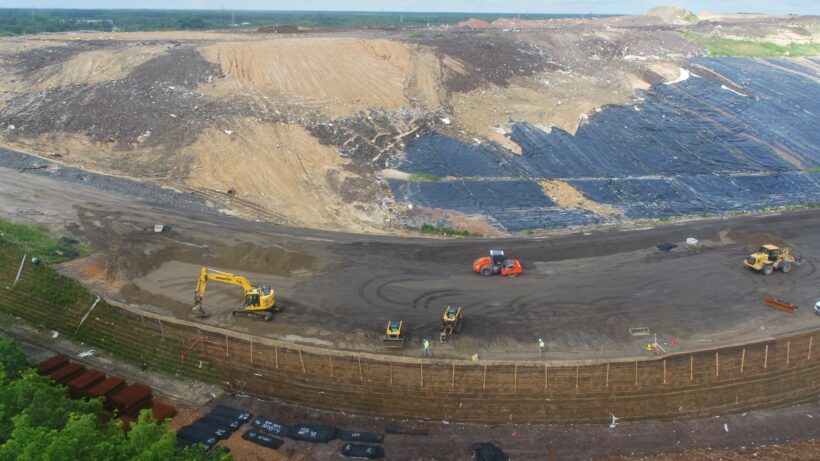Landfill expansion
What is a landfill?
A landfill is an engineered site designed for the safe disposal of waste materials, preventing environmental contamination. Landfills manage both non-hazardous and hazardous waste, with specific measures to contain and neutralize hazardous substances over time.
The uses of landfills are diverse and critical. These are used for managing residential, commercial, and industrial garbage among others, which cannot be recycled or incinerated. The advantages of landfills are numerous including their ability to handle large volumes of waste, and the possibility for recovery of energy through landfill gas and they thus form part of integrated waste management planning.
Types of landfill:
Landfills can be classified into various categories based on their design and purpose. These include:
- Vertical Landfills: Vertical landfills are intended to reduce the amount of land used by building upwards. Such a landfill is helpful in cases where there is little space and it’s possible to efficiently dispose of waste with less usage of the soil.
- Horizontal Landfills: With horizontal landfills, garbage is spread out widely but at shallower depths. In certain instances, areas can have an abundance of land that are available so addressing different directions that trash has been distributed becomes crucial.
- Hybrid Landfills: Hybrid landfills combine the characteristics present in both vertical and horizontal landfills. They also help in optimizing space utilization by taking advantages from each type thereby making them suitable under different geographical and economic conditions.
Another classification of landfills can also be done based on the type of waste they handle and their design features. These include:
- Municipal Solid Waste (MSW) Landfills: Designed to handle household and non-hazardous commercial waste, equipped with systems for leachate collection, gas collection, and environmental monitoring.
- Industrial Waste Landfills: Manage non-hazardous industrial waste with specific design features to handle particular types of industrial by-products.
- Hazardous Waste Landfills: Engineered to safely contain hazardous waste with stringent containment measures such as double liners and rigorous environmental monitoring.
- Construction and Demolition (C&D) Landfills: Specifically designed for debris from construction, renovation, and demolition projects, including materials like concrete, wood, metals, and asphalt.
- Bioreactor Landfills: Utilize controlled addition of liquid and air to accelerate the decomposition of organic waste and enhance methane production for energy recovery.
By using this standard classification, your blog will accurately reflect the types of landfills recognized in the field of civil engineering.
Techniques and methods of landfill management:
Effective landfill management is crucial for minimizing environmental impact and maintaining long-term functionality. Some key techniques and methods are:

- Perimeter retaining walls: Perimeter retaining walls provide structural support to the landfill, preventing lateral movement of waste that would otherwise destabilize it. These walls play an important role in regulating landfills’ boundaries thus enabling safe containment conditions for waste materials in them.
- Mechanically stabilized earth (MSE): MSE systems have been employed for embankments and slope stabilization in landfills too. They can effectively resist pressures from wastes hence creating stable structures that will last longer.
- Veneer stability: Veneer stability keeps cover materials from sliding on landfill slopes. It ensures the stability of the top layers of waste and cover materials, reducing the risk of surface failures.
- Landfill capping: A cover system is used in landfill capping which involves sealing off the top layer to prevent water infiltration into the ground and control gas emissions. This step is important in landfill site closure as well as post-closure management by reducing environmental impacts.
- Landfill mining: The recovery of valuable materials, reduction in the volume occupied by a landfill, or remediation of contaminated sites can be achieved through landfill mining operations. It forms part of sustainable waste management strategies because they encourage resource conservation alongside environmental reclamation.
- Piggyback landfill: This is a method of putting up a new landfill above an old one. This way, available space is maximized and the life of the landfill site is extended, hence it is an economical and effective mode of waste management within the country.
Role of geosynthetics in landfill expansion
Geosynthetics have a significant role to play in landfill expansion including reinforcement, filtration, drainage, and separation. A good number of geosynthetic products applied in landfills are:
- Geotextiles: These are permeable geosynthetic fabrics used for separating, filtering, reinforcing, and draining parts of a landfill. They restrict soil migration and strengthen the construction stability of liners and covers of landfills.
- Geogrids: geogrids are employed for reinforcing landfill slopes as well as embankments which can also be called landfill caps or berms. Soil’s load-bearing capacity is enhanced by these materials thereby achieving long-term stability and preventing slope failures.
- Geonets: Geonets offer efficient drainage paths that prevent the collection of leachate and landfill gas. They enhance drainage while protecting the liner’s integrity.
- Geocomposites: They serve all the functions offered by geotextiles, geogrids, and geonets combined therefore they provide complete solutions to landfills’ management system. Their use supports reinforcement, drainage, and filtration thus increasing the overall efficiency and longevity of such facilities.
- Geocells: Geocells can be used to stabilize the surface of caps on landfills plus slopes holding them together firmly. Erosion becomes impossible with such systems; while at the same time, there will be uniformity over bearing weight as well as structural integrity improvement for the landfill cover system.
At Strata Global, we specialize in providing state-of-the-art geosynthetic solutions tailored for landfill expansion projects. Our eco-friendly products are designed to enhance sustainability, durability, and cost-effectiveness in waste management practices. You can trust in our commitment to delivering innovative solutions that pave the way for a greener, more efficient future. Partner with us today and revolutionize your landfill expansion endeavors!
